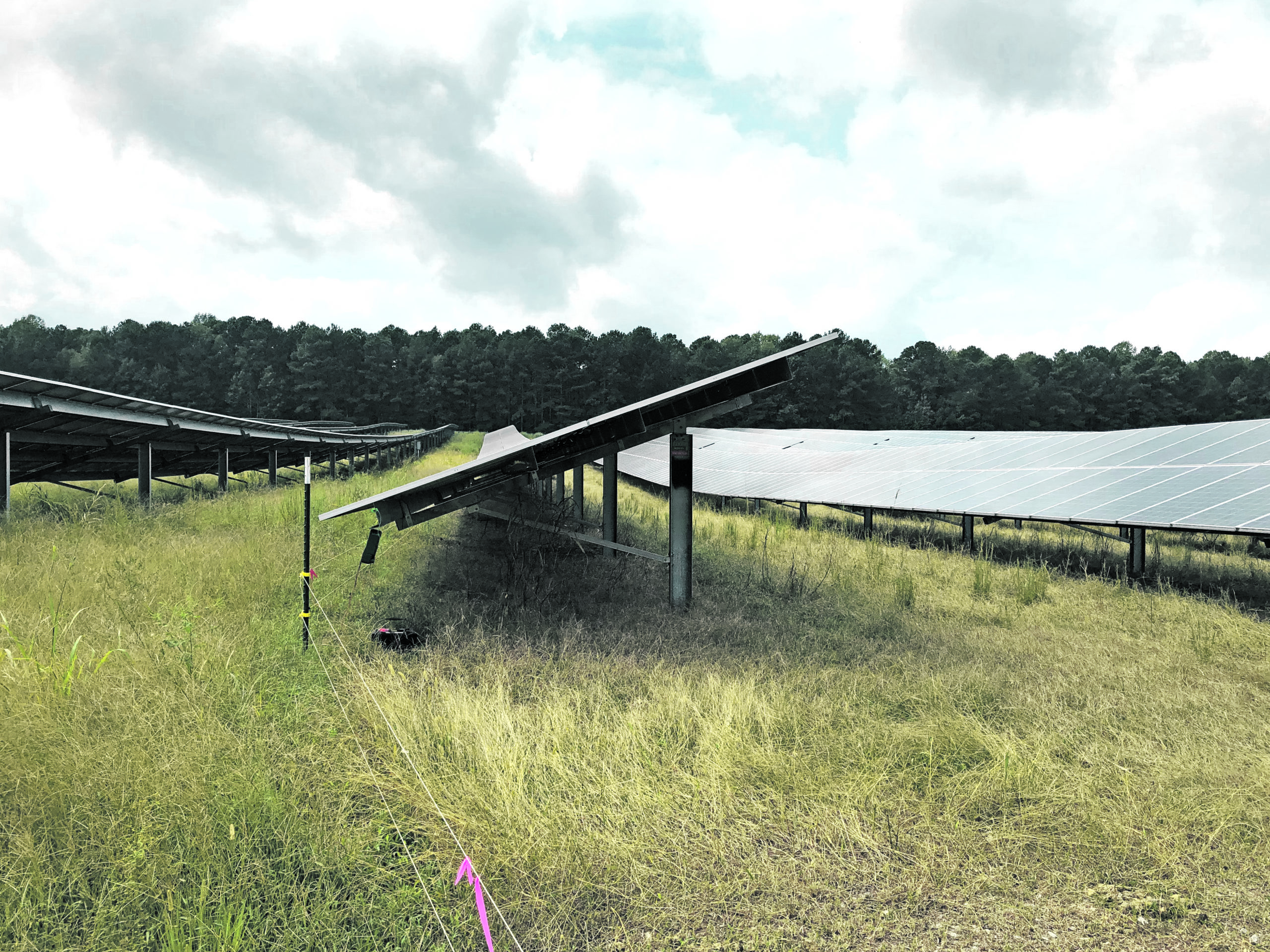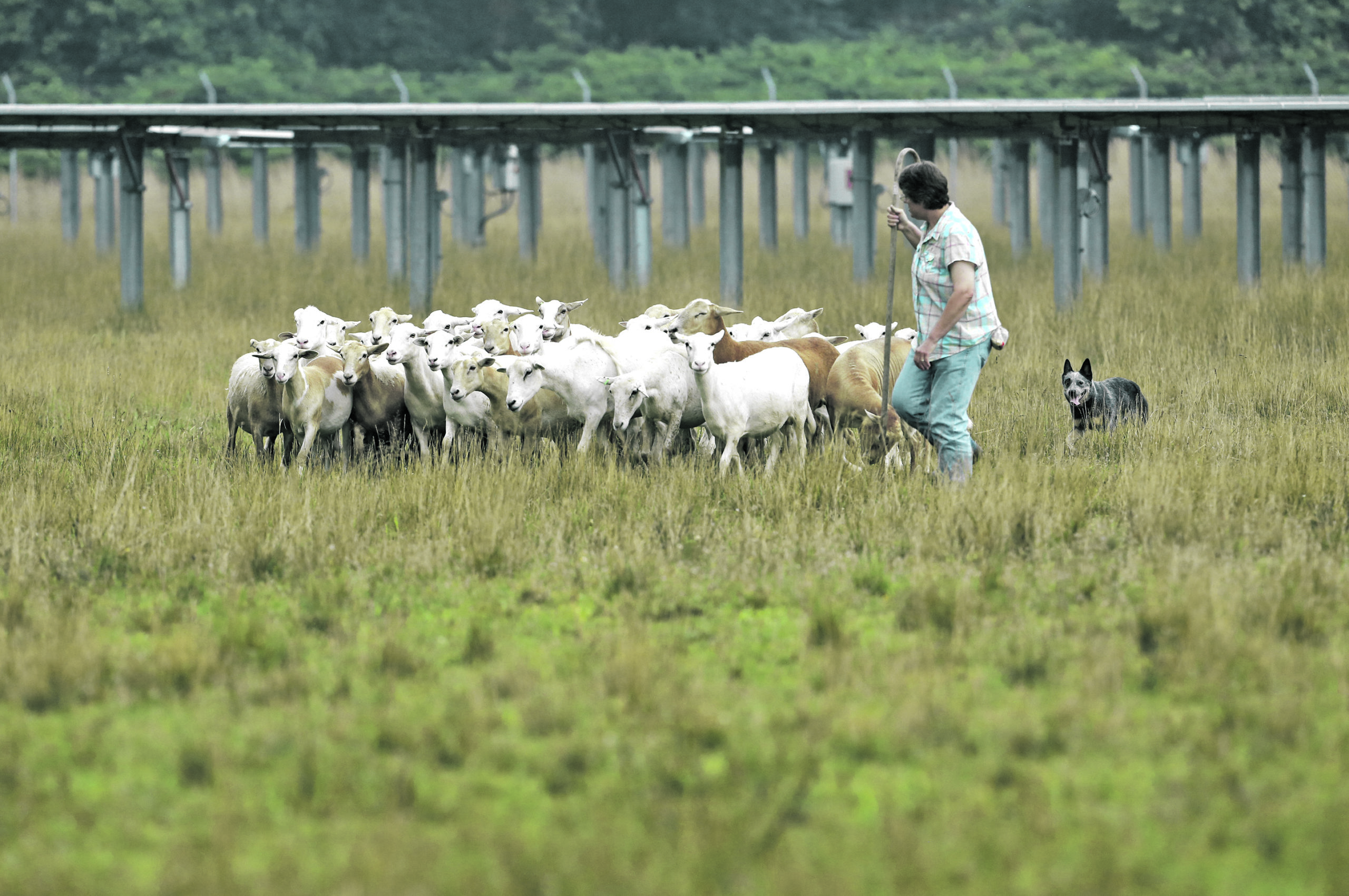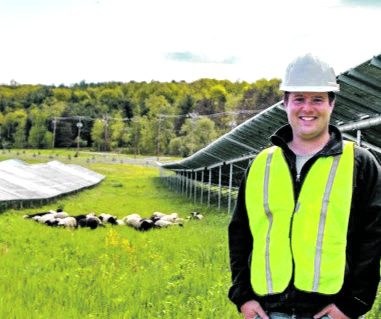Faces of Solar Grazing
In part three of our “Solar Grazing“ series, meet some graziers and learn about their operations.

This is what the two-strand fence looks like when Carolina Solar Services is about to move the sheep into a paddock.
In this article, we will look at how each solar grazier has organized their operation and how they have benefited from membership in the American Solar Grazing Association (ASGA). Lewis Fox, Julie Bishop, and Carolina Solar Services were all kind enough to share their knowledge and experience of solar grazing because they want to see other farmers be successful in this emerging field.
For Julie Bishop, it all started with an Australian Cattle Dog, Mandy, who wanted some sheep to work. Before long Julie was running out of room on her 6-acre home farm, so she went looking for more pasture and found a fenced-in solar array. When she saw that the array was being mowed she thought, “What a waste!” She approached the solar company and eventually got a contract to maintain the vegetation, and that’s how Solar Sheep LLC in Newfield, New Jersey was born. News about Julie and her sheep got around, and soon she was grazing multiple locations in New Jersey. She started with a flock of 50 sheep grazing 15 acres of solar, and now manages 85 acres of solar arrays full-time with 450 sheep.
Julie’s accumulated experience and wisdom are in demand in other ways too. In addition to being paid for solar grazing services, she is also being paid to assist in designing a 700- acre utility-scale solar site that will be grazed by her expanding flock. She plans to have close to 1000 sheep by 2023. This solar facility will host the sheep year-round and will include lambing barns, feed storage, water, and electric service.

Julie Bishop, her dog Mandy, and the flock moving to a new paddock in the solar farm.
While the sheep are at work, Julie sets up portable fences for the next few paddocks. She’s learned that some sites are not worth dividing up because of their shape or size. She uses the placement of the water and minerals to draw the sheep to areas that need grazing. To transport the flock, Julie has a 24-foot stock trailer with ventilation all the way to the floor. She can fit 50 sheep at a time. Mandy proves her value every time the sheep get rounded up and moved to another site. Mandy can run a whole solar site and find every single sheep. Julie only grazes with full-grown yearlings and ewes and keeps all her lambs at home. It helps her keep track of their health and productivity to ensure her lambs are top quality. Julie raises Katahdins, and lambs in January and February to give her lambs a good long time with their mothers before weaning them. Julie sells lambs for meat and pets and also sells lambs to other solar grazers. Most of her sales come from return customers, word of mouth and as a result of a sign out in front of her house.
Julie says solar grazing is not always as easy as it sounds. She has found many challenges maneuvering her truck and trailer and loading her sheep on sites that were not designed for these activities. She says, “It’s incredibly important to communicate with electrical crews about how to close gates when sheep are at work. Sites with cable trays are also tricky. With proper pre-construction planning with solar companies, many of these challenges can be avoided.” Despite the challenges, so far solar grazing is going well enough to keep her happy and allow her to expand her flock and business. Julie became a member of the American Solar Grazing Association (ASGA) for the community and exchange of information. She sees the value in being part of an organization devoted to the thoughtful implementation of solar grazing so much that she went a step further and became a board advisor to ASGA.

Solar grazier Lewis Fox from Cortland, NY.
A few hundred miles northwest of Julie’s operation is another full-time solar grazier. Lewis Fox of Fox Farm in Cortland, NY is a young farmer with a grass-based sheep operation. Lewis is a graduate from Cornell Animal Science program, and has worked on large-scale cow, goat, and sheep dairies. His goal has always been to have his own business that would support him full-time without outside income. Lewis figured sheep were the most affordable and scalable livestock. He found an old dairy farm for rent and in the Spring of 2017 started with 120 sheep.
In the summer of 2018, Lewis connected with Lexie Hain of Two Mothers Farm, also the founder of ASGA. She had a contract to graze a solar site but needed more sheep to deal with the vegetation effectively, so she convinced Lewis to use his flock to graze half the site. Initially he was a little skeptical of this new enterprise, but he was pleasantly surprised at the end of the grazing job because everything worked out so well.
Lewis now grazes his flock on solar sites from May-November. He lambs on the rented home farm during the late winter months. After weaning the lambs in April, he sells them live to other farmers, or at the local auction at the end of the growing season. Because of all the additional land he can access at the solar sites, he can manage more than double the sheep his farm acreage could sustainably support. When the sheep come home for the non-growing months he is able to provide them with all they need in stockpile and hay.
Starting to solar graze created predictable cash flow, which allowed Lewis to grow his business. So far it is very meaningful and it supports his life.
Beyond hands-on grazing work, Lewis is now transferring his professional livestock skills to a consulting business called Agrivoltaics. He is seeing encouraging growth, with dozens of large-scale solar projects planned or under construction in NY. He also sees opportunity for improvement in the design of solar arrays to make sheep grazing more efficient. The American Solar Grazing Association is lucky to have Lewis on its board of directors because he is a perfect advocate for farmers’ interests in the corporate world of renewable energy.
A few states to the south is another example of people making solar grazing work for them. Carolina Solar Services (CSS) was originally started as an operations and management company that provides electrical and vegetative management services to solar companies. The idea of sheep grazing instead of mowing came from company founder Zack Hobbs. In 2016 Zack diversified the company to include 80 sheep to balance out mechanical and chemical management. Grazing also increases site safety and saves time and labor.
As both the flock size and solar acreage he was managing scaled up, Zack was challenged by the time required to handle sheep, so he hired experienced stockman Brock Phillips to manage 590 sheep on 300 acres of solar sites.
Zack owns a farm near Durham, NC and has room for all the ewes to spend the winter and have their lambs. For their operations to be successful the ewes must get out on the arrays by early May and stay out as late as November.
When the ewes are at work on the solar sites, Brock builds 3-5-acre paddocks and uses high stocking density. Each paddock lasts about 4-7 days with 200-300 ewes. Vegetation can grow fast and thick in NC; however there can be droughts too so everything is calibrated by the weather and growing patterns that occur each year. As with any kind of grazing, there is no one formula to follow. Brock points out that close observation and planning are key to success.
Building fences for that many sheep must be efficient, so Brock uses two strands of poly wire, which he runs along the low side of the panels. He carefully places fence posts using electrical layouts to guide the way. He connects the ends of the fence on the chain link perimeter fence with a plastic gate handle that hooks onto the chain link.
To water the sheep, he has a 300-gallon water tank on his truck. Like Julie Bishop, he uses the placement of water and mineral feeders to lure sheep to certain areas. Each fence line needs to be string trimmed and electrified with 8-9000 volts to keep sheep in. With just one border collie, a portable corral, and a double-decker trailer sheep, he can move the flock onto another site.
Unlike the other two graziers profiled above, Carolina Solar Services is also a landscaping company. Sheep are just one of the options they employ for solar site maintenance, and grazing is balanced with other options to best suit the site and available labor force. Carolina Solar Services also employs people to tend to the woody vegetation and broom sedge that sheep don’t eat. Brock finds that solar sites that have been limed and seeded with high-quality pasture mixes need far less mechanical landscaping treatments. Clients have expressed that having the sheep and Brock on site makes them feel more comfortable and secure about their investment. The sheep are very gentle on the solar equipment and Brock can spot and report any anomalies on site. The people in the communities near the solar sites are thrilled to see the sheep at work and it brings agriculture into neighborhoods that have been lacking livestock.
Every year they sell their lambs at auction, but this year they are working on creating a better marketing program for their lamb in their local area. Because their focus is on providing quality vegetative management, marketing lambs is secondary.
This year they are trialing sheep services on a subscription payment system that is based on a per-acre price. They are aiming to create more of a pastoral look while increasing the biological diversity and soil health of the land they work on.
CSS sees that there is a very big opportunity for sheep farmers to form networks like the American Solar Grazing Association that can coordinate with big solar companies. These solar companies otherwise generally don’t understand an agricultural mindset or what would be involved in using sheep for site maintenance. ASGA helps educate and advocate by developing and sharing solar grazing best practices with both farmers and solar developers.
All over the country we are seeing an increase in solar development, which is creating opportunities for new profitable farming enterprises. The American Solar Grazing Association is knitting together all the information for existing and potential solar grazers to be successful in this new era of agrivoltaics.
This article was originally published in On Pasture. Visit onpasture.com for more great grazing information.

